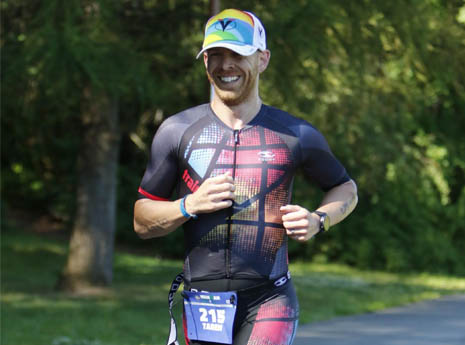When new triathletes enter the sport, one of the most overwhelming issues is the amount of gear they need. Having to buy gear for the swim, bike and run, for cold weather and hot weather, for traveling, for rainy days, for indoor training—the list of expenses can literally be endless. In this guide, we're going to go through the 10 essential items triathletes should buy once they're committed to doing more than just one race.
No. 1 Speedo or Jammers
Triathletes have a hard-enough time learning how to swim; baggy swim trunks are like a giant parachute that will slow a swimmer down and make their legs sink. Make swimming much easier with a Speedo or a pair of jammers.
No. 2 Wetsuit
Not only are wetsuits mandatory in some races, they also provide buoyancy and warmth in the water, reducing the likelihood of drowning and nervous shivers during the swim. I've never met a new triathlete who couldn't benefit from the use of a wetsuit from both a safety and an enjoyment perspective. If you're still on the fence, get an inexpensive triathlon-specific wetsuit from Amazon for under $200, and if you end up not using it, you can likely resell it for almost as much as you paid. That will end up being less expensive than even renting.
No. 3 Multi-Purpose Swim Goggles
Leaky goggles, foggy goggles, goggles with too much glare—it all makes for a less enjoyable triathlon and swim training experience. Find a pair of goggles that fits comfortably without having to make them too tight. They should suction onto your face without having to press them whatsoever. I also suggest getting the mirrored option, which will be fine in the pool and reduce glare from the water on race day.
No. 4 Aerobars
Eighty to 85 percent of the drag triathletes need to push themselves through while on the bike comes from the body, so getting a set of aerobars to narrow the frontal area will be money extremely well spent.
No. 5 Bike Fit
If you can't stay in the aerodynamic aerobar position, you won't be very aerodynamic. A bike fit will get your bike as dialed in as possible, so you can stay comfortable for hours on end in the tucked position.
No. 6 Bike Trainer
Roughly 50 percent of the total race time in most triathlon distances is spent on the bike, so bike fitness is extremely important. Getting an indoor bike trainer is critical to creating consistency in bike training so that, regardless of whether it's cold or rainy, the traffic is bad, you're crunched for time or it's just not safe for you to ride outside, you can still get in good workouts.
No. 7 Triathlon Shorts
Rather than getting cycling shorts and triathlon shorts, most triathletes will be able to get by with just the less-padded triathlon version. These shorts will still be nice and aerodynamic and still have padding, but the padding in triathlon shorts is much less than what's in cycling shorts so triathletes can also run and race in them (racing is way more difficult in traditional cycling shorts because the big pad creates a soggy-diaper feeling after the swim).
No. 8 Cycling Jersey
For covering the torso, I recommend a cycling jersey instead of a triathlon top. The cycling jersey will be aerodynamic and will keep the sun off your shoulders during training while a tri top will tend to be sleeveless, which allows for a greater chance of sunburn.
No. 9 Good Running Shoes
Running shoes really do expire. They become squishy and less responsive after a period of time, leading to a greater likelihood of injury. Running shoes should be replaced every 200 to 400 miles and be rotated so you don't run on the same pair of shoes on back-to-back days. Find a pair of shoes that feels comfortable and allows you to run naturally.
No. 10 Injury Prevention Gear
Finally, every triathlete will experience niggles, aches and pains. These niggles that pop up are the first sign of an injury building, and it's best to deal with them before they become full blown problems. Depending on what aches and pains you have, triathletes will need to have one of (or all of) the following: a trigger point ball and foam roller, a leg roller, Therabands and many other "torture" devices. To know what you should get, go to a sports medicine clinic that sells injury prevention products, tell them where your aches and pains are and have them recommend what will work best for you.
With these 10 items, every triathlete will have an excellent base of gear to start with to keep them training regularly with as good a return on investment as possible. Everything else in triathlon can gradually be purchased over the following years and decades.
READ THIS NEXT: 7 Mistakes Beginner Triathletes Make When Swimming
About the Author









Discuss This Article